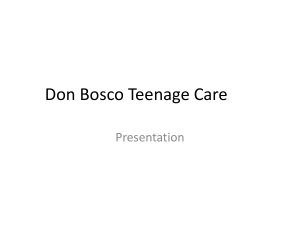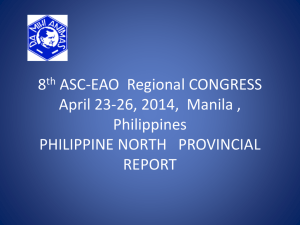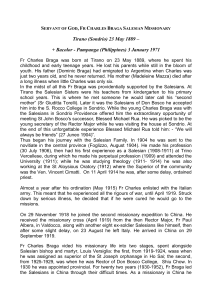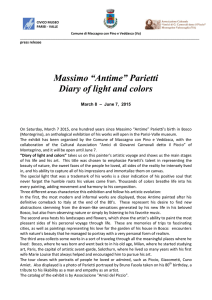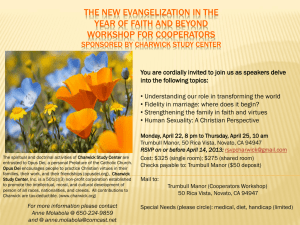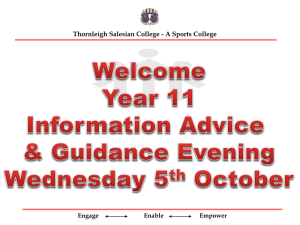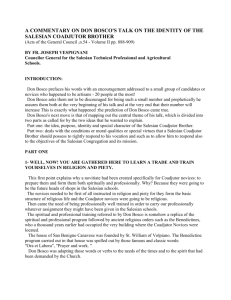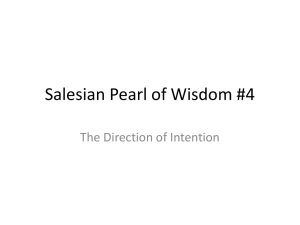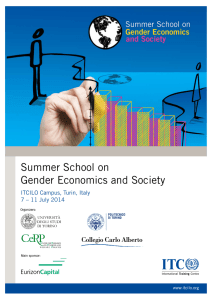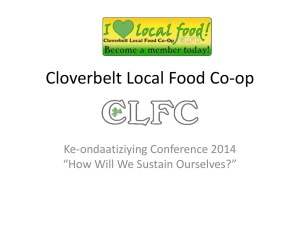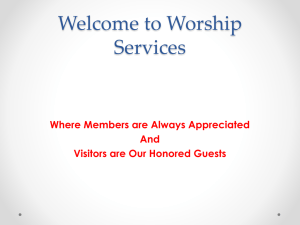History of the ASC
advertisement
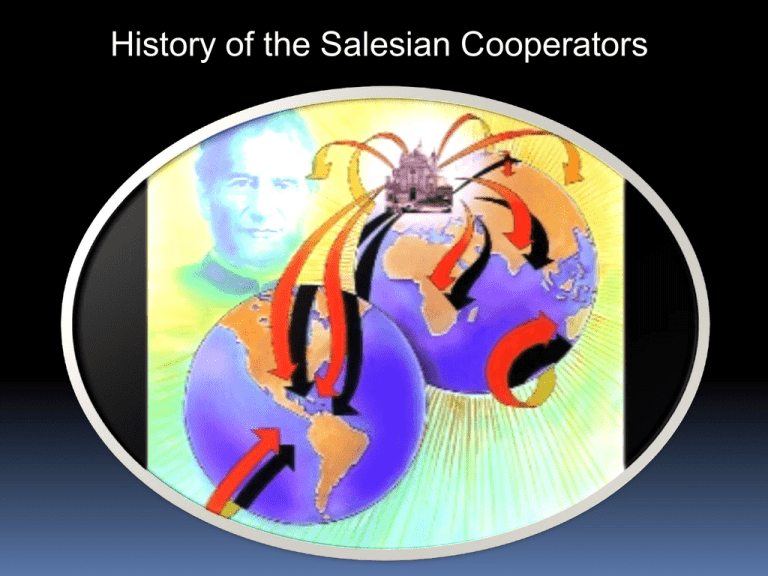
History of the Salesian Cooperators The words of Pope Paul VI (November 3, 1976, Centenary Congress.) We address to you the words which St. Paul wrote to the Collosians: “ These are the ones actually working with me for the Kingdom of God, and they have been a great comfort to me.” It is usually said: “Don Bosco founded the Cooperators in 1876. No. In 1876 he obtained official recognition for the new juridical status of the Cooperators and published the regulations to make it autonomous. For Don Bosco the Cooperators of 1876 were in unbroken succession the brothers and sisters of those in 1850. Where did the Cooperators come from? Who ever recognized or approved them? Archbishop Gastaldi of Turin asked. He made difficulties for Don Bosco over the Cooperators and refused to permit him to organize new groups of them. In Defense, Don Bosco was able to reply. “ Excuse me your Excellency. They have existed for thirty-five years, and for twenty-five years they have been recognized by virtue of decrees issued in 1850 and 1852.” Reading a seven page document, he read the document to Archbishop Gastaldi. “ When the Holy See benevolently deigned to concede even more ample favors to the Salesian Cooperators (with its Brief of May 9, 1876) it referred to a “ Pious Union of Christian s canonically instituted, whose members propose principally to take care of poor and abandoned youth.. A work which in turn had been formally approved in 1852. While some of the Promoters join together in common life in 1852 (SDBs)., others continued to live at home with lay status but retain their group membership ( Extern Salesians). Those whole live in common life Extern Salesians Therefore , the Salesian family does not consist of separate individual groups born separately and later united to form a whole; rather it grew in the manner of a single vital organism, developing biologically by division from a single primitive cell. SDB ACS FMA-1872 The history of the Cooperators goes back to 1841 when I began to gather together poor and abandoned boys in the city of Turin (BM XI, 73). Now he used the same words when writing the Salesian Society, “It was initiated in 1841” (constitution First Draft 1858 ) For Don Bosco the beginnings of our Salesian work and the beginning of the Cooperators were contemporaneous. The first Salesian Cooperators (ACS) Secular Priests: Joseph Cafasso Lawrence Gastaldi Peter Merla Ignatius , Joseph Vola Francis Marengo John Baptist Borel Louis Nasi The lay helpers: Count Cays of Giletta (later became SDB) Marquis Fasatti Marchioness Fasatti Count Callori of Vignale Count Scarampi of Pruney Joseph Gagliardi Mama Margaret The Congregation of St. Francis de Sales, which was recognized by the Holy See included the externs. This was also diocesan since its members were all from Turin. From these group, which later was called the Congregation of Salesian Promoters and Cooperators, were joined by the day students and the boarders. The best of these would , in 1859 become the first members of the Pious Salesian society. (page 77. Renewal of our Salesian life by Father Joseph Aubrey, SDB.). Presence of the salesian Cooperators in the Draft of Salesian Constitutions. Don Bosco sent all the documents to Rome to obtain papal approval on February 11, 1864. The following is the text of the famous Chapter XVI entititled “ External Members.” 1. Anyone can belong to our society, even while living at home with the family. 2. No vows are made, but everyone undertakes to put into practice that part of the present regulations which is compatible with one’s age, state and condition, whether this would involve teaching catechism to poor boys, promoting the diffusion of good books, or working to put on triduums, novenas. 3. In order to share in the spiritual benefits of the society, the external member must at least make a promise to the Rector to make use of whatever means and resources are available for advance of works for the greater glory of God. 4. Such a promise made of the society who leaves it for whatever reason is considered an external member and still shares in the spiritual benefits of the entire society, provided that he practices that part of the regulations prescribed for external members (MB VII, 885). The Sacred Congregation for Bishops and Regulars issued a Decree of Commendation recognizing the existence of the new society on June 23, 1864. Formal approval of the rules was deferred. Chapter XV1 was disapproved by the Sacred Congregation. “It is not possible to approve the inscription by affiliation of the persons outside the Pius Instiutute. Religious and lay people amalgamated together in the same institute. It could never be. It was dangerous.” “ A way of life for secular members which could somehow resemble the life of a religious congregation.” A kind of third order. So on May 9, 1876, Don Bosco obtained from Pope Pius IX the approval of the Union of Salesian Cooperators. 1877 - The first number of Bibliofilo Salesiano now Salesian Bulletin appeared as monthly periodical to unite the spirit of those who have assisted his works. He also conducted eighty conferences, twenty eight of these were done in France. These family reunions are very vital to the expansion of his works. In 1888, after the death of Don Bosco, the Salesian Society grew tenfold because of the Salesian Cooperators. In Italy Father Rua succeeded by using the following method: Whenever a sufficiently important group of Cooperators became established in a diocese, he would ask the bishop to appoint a diocesan director . The director would recommend the decurioni (group leaders) to the rector major.( Don Bosco and the Salesians, page 77) In April 1895, about 2,000 participated in the Bologna Congress. For three days the work of Don Bosco in the field of education, social action, the press, the mission was eulogized. Don Rua also initiated the Manual of Theory and Practice printed in Turin 1893 - now revised, on how Cooperators can help the Salesians in their work. And he stressed that every Cooperator ought to be a Catechist. The rector majors that followed Blessed Michael Rua had always been faithful in following Don Bosco’s footsteps. . Don Bosco appealed before he died to support his sons even after his death. In 1962 for example there were already one thousand centers under the Rector Major Ricaldone. He also took seriously the promotion of the “Volunteers o f Don Bosco”, formerly called Oblates, started by Blessed Rinaldi himself. Don Bosco’s mother, Mama Margaret is the First Salesian Cooperator. Her teachings we know became the pillars of the Salesian Charism. Some Exemplary Salesian Cooperators: Dorothy Chopitea Charles d’Espiney (1891) Rev. Father Felix Reviglio (St. Augustine Parish, Turin) Leon Rolland (Toulon 1900) Father Bauer (Madrid) Blessed Alexandrina Maria da Costa (Portugal) Blessed Alexandrina Maria da Costa What is singular in Don Bosco’s case is that his mother was not only present with him at the actual foundation on his work but remained there as primary and principal cooperator and helper, thus taking a direct and immediate part in the moulding the charism of this particular foundation.
